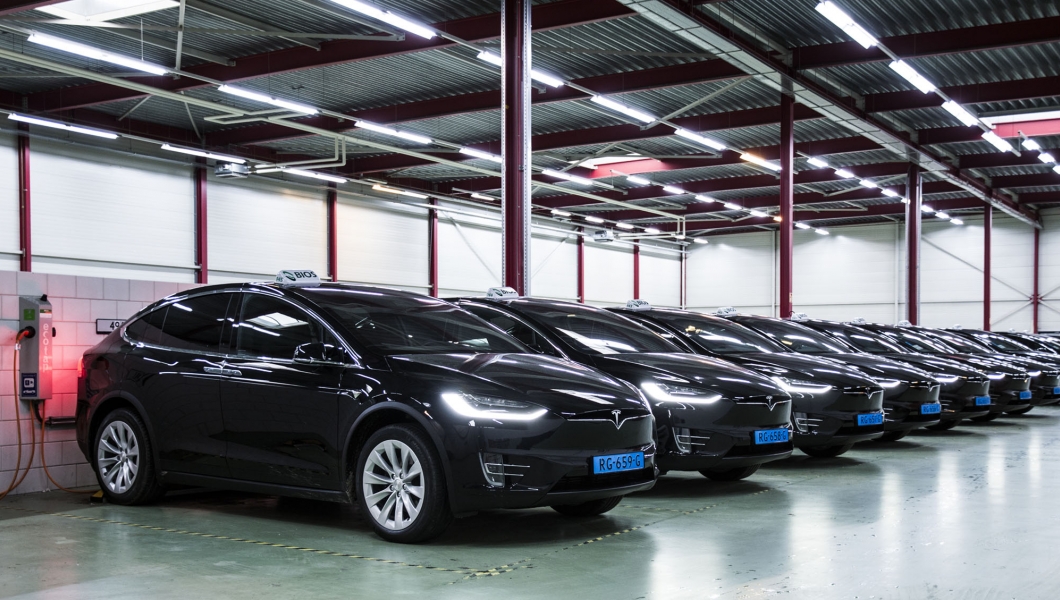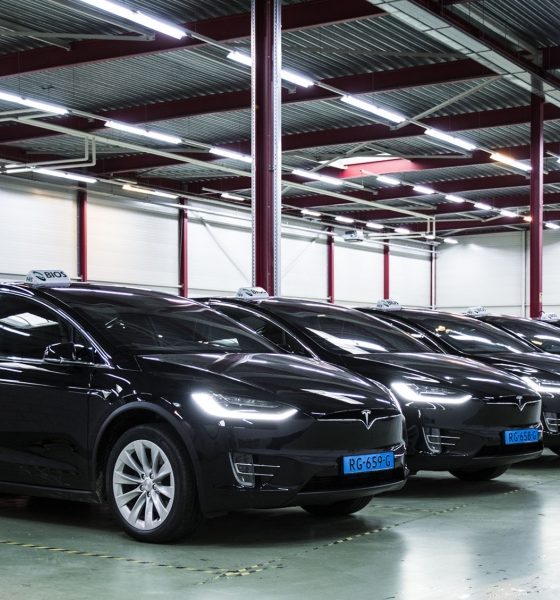

News
Tesla could land $500 million dollar payday, courtesy of Fiat Chrysler in emissions tradeoff
Tesla and Fiat Chrysler have entered into a deal to help the legacy automaker weather strict European Union emissions regulations that are set to take effect next year, according to a report published by Financial Times. This arrangement is the first of its kind and is estimated by one Wall Street firm to equate to $500+ million dollars worth of credits to Tesla from Fiat Chrysler over the next 2-3 years.
Jefferies on the @Tesla @fiat open pooling arrangement:
"We assume that compensation to Tesla could be in excess of $500m relating to 2020 and 2021 each with payments possibly starting earlier (2019) to spread costs".
— Patrick McGee (@PatrickMcGee_) April 8, 2019
Beginning in 2020, 95% of automotive fleet-wide emissions in the EU must average under 95g of CO2 per kilometer, i.e., have a fuel efficiency of about 57 mpg for internal combustion vehicles. In 2021, full fleets must be compliant, and the penalties could add up to financial ruin for companies unable to meet the strict standards.
The EU rules further allow different auto companies and divisions to pool together to form an expanded fleet, thus averaging out emissions across larger numbers of vehicles. Companies with existing low or zero emissions divisions can combine with their higher emissions divisions to meet the standards, or if the benefit outweighs the awkward arrangement, they can combine with companies like Tesla whose all-electric, zero emissions fleets would provide significant average emissions reductions.
Tesla offered its “open pool” deal to other auto manufacturers, but the Italian-American car maker was the only one with an arrangement by Tesla’s March 25th deadline. Fiat Chrysler has been slower than its industry peers to adopt an electrification plan for its vehicles sold in the region and needed to buy more time until a strategy could be worked out. The company has announced a $10.5 billion dollar plan to bring alternative power to its vehicle lineup, but any efforts in that direction will not manifest into enough production vehicles to avoid the EU fines by the impending deadline.

Under EU rules, Tesla qualifies for “super-credits” which allow a trade-off of electric car sales against ICE vehicles; the company has already managed similar profitable credit trades in California that brought in $280 million dollars in 2017. This number may be where the estimated $500+ million payout figure from Jeffries Financial Group is stemming from. Altogether, the pooling arrangement looks to be a temporary win-win for the two companies, and the deal was reportedly agreed to on February 25th.
Tesla has become a proven leader in developing emissions-free transportation. Since the release of its flagship Model S luxury sedan, the car’s appeal has fueled both the growth of the company – now on its fourth mass-produced electric vehicle with a fifth on the way – and new market demand for electric cars. Tesla’s competitors have taken note and many have committed billions to electrification of their fleets, even without looming EU regulations. US auto industry giant Ford Motor Company, for example, is planning an $11 billion investment into 40 electrified vehicles by 2022, as announced at last year’s Detroit Auto show.
Overall, the “Tesla Effect” on the global market has only begun, and the beginning of the EU’s strict emissions regulations may be the tip of the iceberg of changes coming to the numerous industries impacted by the coming shifts in the automotive arena.

Elon Musk
Starlink passes 9 million active customers just weeks after hitting 8 million
The milestone highlights the accelerating growth of Starlink, which has now been adding over 20,000 new users per day.

SpaceX’s Starlink satellite internet service has continued its rapid global expansion, surpassing 9 million active customers just weeks after crossing the 8 million mark.
The milestone highlights the accelerating growth of Starlink, which has now been adding over 20,000 new users per day.
9 million customers
In a post on X, SpaceX stated that Starlink now serves over 9 million active users across 155 countries, territories, and markets. The company reached 8 million customers in early November, meaning it added roughly 1 million subscribers in under seven weeks, or about 21,275 new users on average per day.
“Starlink is connecting more than 9M active customers with high-speed internet across 155 countries, territories, and many other markets,” Starlink wrote in a post on its official X account. SpaceX President Gwynne Shotwell also celebrated the milestone on X. “A huge thank you to all of our customers and congrats to the Starlink team for such an incredible product,” she wrote.
That growth rate reflects both rising demand for broadband in underserved regions and Starlink’s expanding satellite constellation, which now includes more than 9,000 low-Earth-orbit satellites designed to deliver high-speed, low-latency internet worldwide.
Starlink’s momentum
Starlink’s momentum has been building up. SpaceX reported 4.6 million Starlink customers in December 2024, followed by 7 million by August 2025, and 8 million customers in November. Independent data also suggests Starlink usage is rising sharply, with Cloudflare reporting that global web traffic from Starlink users more than doubled in 2025, as noted in an Insider report.
Starlink’s momentum is increasingly tied to SpaceX’s broader financial outlook. Elon Musk has said the satellite network is “by far” the company’s largest revenue driver, and reports suggest SpaceX may be positioning itself for an initial public offering as soon as next year, with valuations estimated as high as $1.5 trillion. Musk has also suggested in the past that Starlink could have its own IPO in the future.
News
NVIDIA Director of Robotics: Tesla FSD v14 is the first AI to pass the “Physical Turing Test”
After testing FSD v14, Fan stated that his experience with FSD felt magical at first, but it soon started to feel like a routine.

NVIDIA Director of Robotics Jim Fan has praised Tesla’s Full Self-Driving (Supervised) v14 as the first AI to pass what he described as a “Physical Turing Test.”
After testing FSD v14, Fan stated that his experience with FSD felt magical at first, but it soon started to feel like a routine. And just like smartphones today, removing it now would “actively hurt.”
Jim Fan’s hands-on FSD v14 impressions
Fan, a leading researcher in embodied AI who is currently solving Physical AI at NVIDIA and spearheading the company’s Project GR00T initiative, noted that he actually was late to the Tesla game. He was, however, one of the first to try out FSD v14.
“I was very late to own a Tesla but among the earliest to try out FSD v14. It’s perhaps the first time I experience an AI that passes the Physical Turing Test: after a long day at work, you press a button, lay back, and couldn’t tell if a neural net or a human drove you home,” Fan wrote in a post on X.
Fan added: “Despite knowing exactly how robot learning works, I still find it magical watching the steering wheel turn by itself. First it feels surreal, next it becomes routine. Then, like the smartphone, taking it away actively hurts. This is how humanity gets rewired and glued to god-like technologies.”
The Physical Turing Test
The original Turing Test was conceived by Alan Turing in 1950, and it was aimed at determining if a machine could exhibit behavior that is equivalent to or indistinguishable from a human. By focusing on text-based conversations, the original Turing Test set a high bar for natural language processing and machine learning.
This test has been passed by today’s large language models. However, the capability to converse in a humanlike manner is a completely different challenge from performing real-world problem-solving or physical interactions. Thus, Fan introduced the Physical Turing Test, which challenges AI systems to demonstrate intelligence through physical actions.
Based on Fan’s comments, Tesla has demonstrated these intelligent physical actions with FSD v14. Elon Musk agreed with the NVIDIA executive, stating in a post on X that with FSD v14, “you can sense the sentience maturing.” Musk also praised Tesla AI, calling it the best “real-world AI” today.
News
Tesla AI team burns the Christmas midnight oil by releasing FSD v14.2.2.1
The update was released just a day after FSD v14.2.2 started rolling out to customers.

Tesla is burning the midnight oil this Christmas, with the Tesla AI team quietly rolling out Full Self-Driving (Supervised) v14.2.2.1 just a day after FSD v14.2.2 started rolling out to customers.
Tesla owner shares insights on FSD v14.2.2.1
Longtime Tesla owner and FSD tester @BLKMDL3 shared some insights following several drives with FSD v14.2.2.1 in rainy Los Angeles conditions with standing water and faded lane lines. He reported zero steering hesitation or stutter, confident lane changes, and maneuvers executed with precision that evoked the performance of Tesla’s driverless Robotaxis in Austin.
Parking performance impressed, with most spots nailed perfectly, including tight, sharp turns, in single attempts without shaky steering. One minor offset happened only due to another vehicle that was parked over the line, which FSD accommodated by a few extra inches. In rain that typically erases road markings, FSD visualized lanes and turn lines better than humans, positioning itself flawlessly when entering new streets as well.
“Took it up a dark, wet, and twisty canyon road up and down the hill tonight and it went very well as to be expected. Stayed centered in the lane, kept speed well and gives a confidence inspiring steering feel where it handles these curvy roads better than the majority of human drivers,” the Tesla owner wrote in a post on X.
Tesla’s FSD v14.2.2 update
Just a day before FSD v14.2.2.1’s release, Tesla rolled out FSD v14.2.2, which was focused on smoother real-world performance, better obstacle awareness, and precise end-of-trip routing. According to the update’s release notes, FSD v14.2.2 upgrades the vision encoder neural network with higher resolution features, enhancing detection of emergency vehicles, road obstacles, and human gestures.
New Arrival Options also allowed users to select preferred drop-off styles, such as Parking Lot, Street, Driveway, Parking Garage, or Curbside, with the navigation pin automatically adjusting to the ideal spot. Other refinements include pulling over for emergency vehicles, real-time vision-based detours for blocked roads, improved gate and debris handling, and Speed Profiles for customized driving styles.








